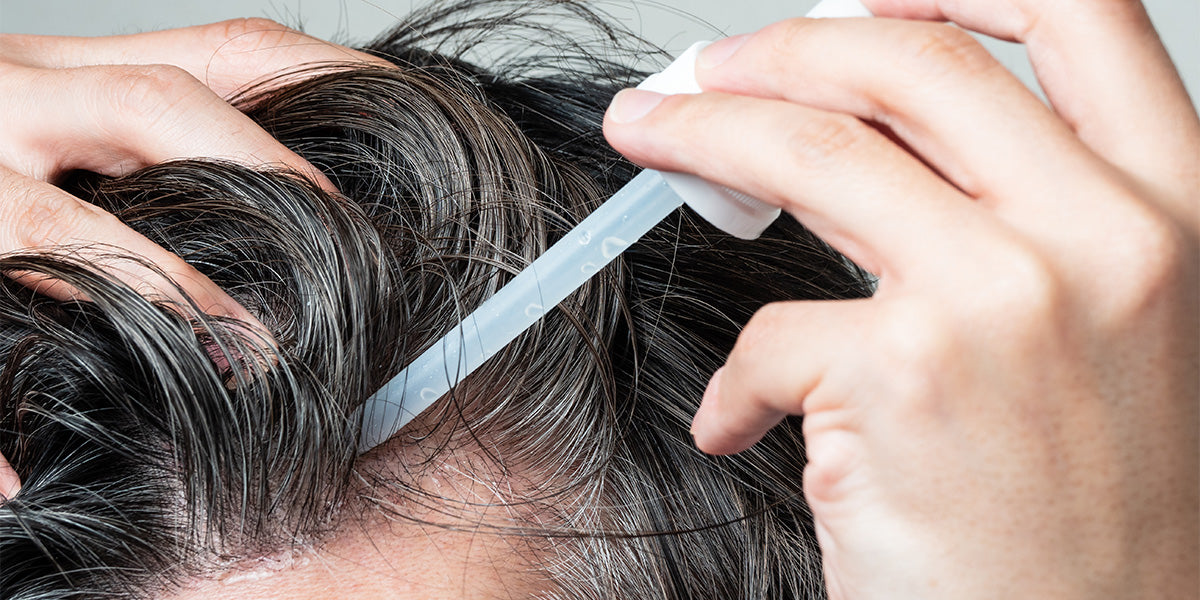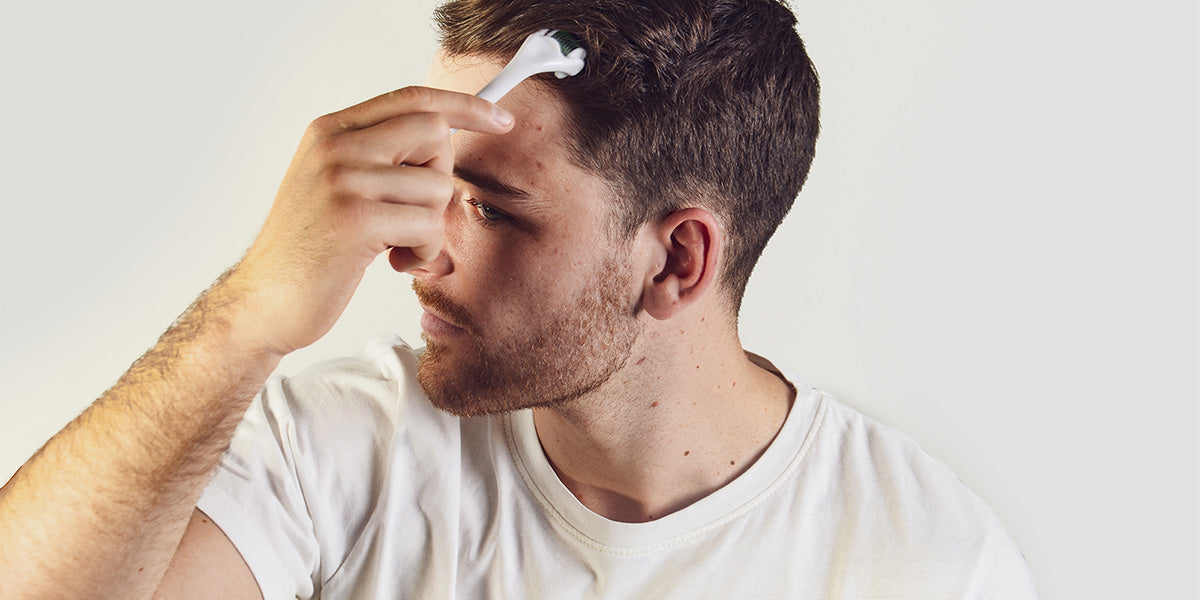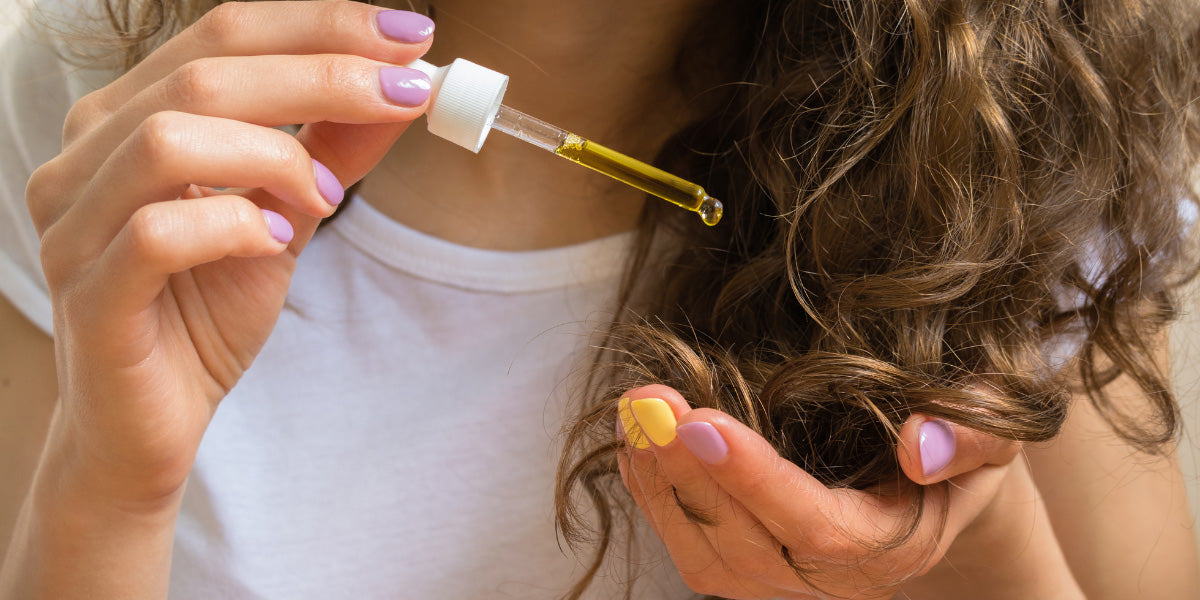Rogaine works well but only for certain types of hair loss, and it delivers the best results when used consistently and as directed.
If you’ve ever looked into hair loss solutions, the name Rogaine® probably rings a bell. It’s the trademarked name for generic minoxidil, which is a popular over the counter medication for hair loss that’s applied directly to the scalp to help promote healthy hair growth and regrow hair. You might be thinking, if it was really that easy, nobody would go bald, right?
We’re going to get to the bottom of whether Rogaine® truly works and talk about a few reasons why people might experience different results while using this treatment.
What is Rogaine®?
Rogaine®, which is the brand name for a medication called minoxidil, is an FDA and Health Canada approved treatment for pattern hair loss. It’s available in two concentrations, (2% and 5%) and it comes as a foam or a solution. Because it’s a topical treatment, Rogaine® should be applied directly to the affected areas of the scalp.
Minoxidil belongs to a class of drugs known as anti-hypertensives and it was originally developed to treat high blood pressure. We don’t have a complete understanding of exactly how it works for hair loss, but it does widen the blood vessels in the scalp, improving the supply of blood and essential nutrients to the hair follicles to support hair growth. It’s also believed that minoxidil has a positive influence on the hair growth cycle, causing hair follicles to enter the active growth stage (known as the anagen phase) more quickly and to stay in this active growth phase longer (Messenger & Rudegren,2004).
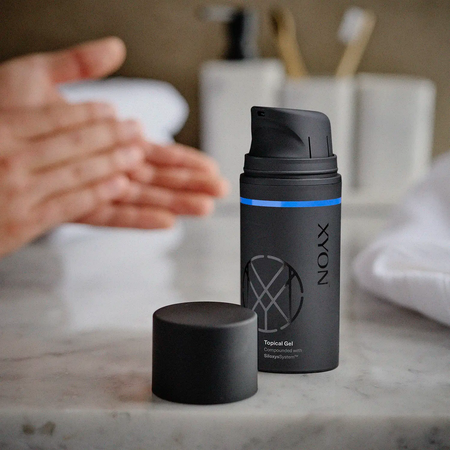
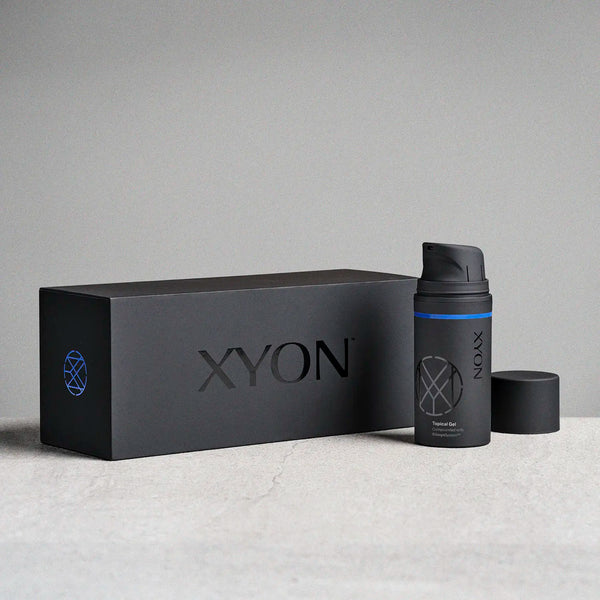
Finasteride + minoxidil in a gel you won't find anywhere else.
Tackle hair loss with a clinically proven combination, shown to help reverse signs of thinning.
Does Rogaine™ really work?
Yes it does, but there are factors such as the type of hair loss and the area of the scalp which may influence how well it works.
How well Rogaine® is likely to work for you is partially down to the root cause of your hair loss. Rogaine® is primarily targeted at those suffering from pattern baldness (androgenetic alopecia) and if your hair loss is triggered by other factors, Rogaine® may not be the right option for you. For example, if your hair loss is due to a scalp infection or inflammation, Rogaine® is unlikely to help.
But this doesn’t mean that it doesn’t work. When used by patients experiencing pattern hair loss, it’s actually proven to be very effective at promoting hair growth. In fact, studies have found a mean difference of up to 14.9cm of hair growth in patients treated with topical minoxidil compared to a placebo group (Suchonwanit et al, 2019). Another study looking at the efficacy of 5% topical minoxidil application over a year, found that the area of hair loss shrunk in 62% of participants and it produced hair regrowth results that 15% of participants considered ‘very effective’ and nearly 50% considered it "effective".
Another point of debate when it comes to; Rogaine® is the differing concentrations available and whether there’s an optimal concentration for hair growth. Both 2% and 5% minoxidil solution are FDA and Health Canada approved for pattern hair loss in men and women. In men, 5% solutions have been shown to produce significantly better hair growth results, with earlier responses to the medication being noted compared to 2% solutions (Olsen et al, 2002). In women, promising results for female pattern hair loss were noted in both concentrations, improving the participants psychosocial perceptions of hair loss, but 2% minoxidil was better tolerated with fewer side effects associated (Lucky et al, 2004). The side effects noted with the 5% topical solution included local irritation and an itchy scalp, as well as excess hair growth on different areas of the body. Based on these findings, there may be subtle differences in the way men and women respond to minoxidil and finding the right concentration for you might take some trial and error.
Can minoxidil regrow my hairline?
Many men experiencing thinning are worried about their hairlines and specifically whether Rogaine® or minoxidil can help.
Some of the uncertainty surrounding the benefits of using Rogaine®, or minoxidil for frontal baldness stems from research findings. Although countless studies have demonstrated that minoxidil can significantly improve hair growth in the crown area of the scalp, there haven’t been many studies that have assessed its efficacy specifically for the hairline. Having said that, one pilot study noted equal improvements in the crown and hairline regions (Mirimarini et al, 2014). More research is probably needed to establish how truly effective it is at regrowing the hairline specifically.
To add to this, the hairline is a notoriously stubborn area of the scalp to treat when it comes to hair loss and this means it can sometimes appear to be less responsive to treatments and this isn’t an issue that is unique to Rogaine®. Other non-minoxidil options like finasteride and dutasteride also encounter the same difficulties when it comes to treating the hairline. It also tends to be the area of the scalp that will experience shedding first, particularly in the case of male pattern balding. Because of this, if treatment isn’t started until later stages of hair loss, follicles along the hairline that experienced shedding first might have already reached the stage of complete miniaturization, being unable to regrow hair.
What causes frontal baldness?
Androgenetic alopecia is the most likely cause of frontal baldness. With this type of hair loss, high levels of a hormone called dihydrotestosterone (DHT) cause the hair follicles on the scalp to shrink and produce weaker strands of hair. Eventually, DHT can render the hair follicles unable to produce hair at all and this will typically begin at the temples of the scalp on men. You’ve probably heard this referred to as a receding hairline.
Other causes of frontal balding:
- Traction alopecia is a type of hair loss that can cause frontal baldness. This is caused by constant tension on the hair follicles due to tight hair styles and use of hair accessories etc. The consistent traction on the hair follicles can cause them to become damaged, but this isn’t usually permanent. Removing tension on the hairs gives hair follicles a chance to recover.
- Frontal fibrosing alopecia is a condition that causes hair loss on the front and sides of the head and it’s thought to be triggered by an autoimmune response in the body, but hormones may also be involved as it often affects women post menopause. It belongs to a category of scarring hair loss, which means that it can be particularly difficult to treat and may be permanent.
Can I use too much Rogaine®?
Much like any medication, using too much Rogaine® may be harmful. Although the active ingredient is targeted at the hair follicles where it’s needed, some minoxidil may enter the blood stream and this can cause side effects.
Common side effects of minoxidil include:
- Headache
- Unwanted facial/body hair
- Dizziness and/or fainting
- Fast or irregular heartbeat
- Chest pain
- Swelling of hands and feet
If you experience any side effects when taking Rogaine®, you should speak to a medical professional right away.
In many cases, minoxidil needs to be applied twice daily and it can take a few months to see results. But it’s important to understand that applying it more often will not increase hair growth and it may increase your risks of experiencing side effects. You should always follow the recommended guidelines when taking hair loss medications and speak to your doctor if you have any questions or concerns.
What if Rogaine® doesn’t work for me?
Everybody’s hair loss journey is unique and we don’t always have an answer for why something works for some people and not others. Fortunately, when it comes to hair loss treatments, you have options. The most important first step to treating your hair loss, is consulting with a doctor and establishing the cause.
Aside from Rogaine®, DHT-blocking drugs can be an effective treatment for androgenetic alopecia and they could work for you even if minoxidil doesn’t. DHT blockers, such as finasteride and dutasteride have a different mechanism of action, working to block the conversion of testosterone into the hormone (DHT) that causes your hair follicles to shrink. Oral finasteride is FDA and Health Canada approved for hair loss for men, but it can also be prescribed off-label as a topical solution. Dutasteride is not FDA or Health Canada approved to treat hair loss in North America, but can also be prescribed off-label or as a compounded topical treatment.
At XYON, we’ve combined the hair regrowth benefits of minoxidil with the DHT blocking effect of finasteride in an innovative 2-in-1 topical gel. For most men, managing DHT levels is an important part of slowing down the progression of hair loss. Using Rogaine® on its own might help, but for the biggest impact, a combination treatment may be your best bet. Our patented SiloxysSystem Gel™ technology helps target minoxidil and finasteride to the hair follicles, while minimizing excess drug absorption to help lower the risk of potential side effects.
For those who opt against topical solutions like Rogaine®, oral minoxidil tablets can also be an option, available to be prescribed off-label, following a consultation with a hair loss specialist. At XYON, we’ve combined oral minoxidil with vitamin D, which is a low dose option that has been formulated to target hair loss. The addition of vitamin D supports normal development of hair cells and protein production, as well as helping to regenerate hair follicles.
Takeaway: does Rogaine® work?
Yes, Rogaine® works. But it’s important to bear in mind that hair loss can be complex and multi-factorial, so the right treatment plan for you might involve using treatments other than Rogaine®. If you have tried Rogaine® and it hasn’t worked as you’d hoped, don’t panic. There are plenty of other treatment options available and we recommend seeking medical advice as soon as possible so that you can establish the best route for you.
References List
Hu, R., Xu, F., Sheng, Y., Qi, S., Han, Y., Miao, Y., Rui, W., Yang, Q. (2015). Combined treatment with oral finasteride and topical minoxidil in male androgenetic alopecia: a randomized comparative study in Chinese patients. Dermatologic Therapy.
Lucky, A.W., Piacquadio, D.J., Ditre, C.M., Dunlap, F., Kantor, I., Pandya, A.G., Savin, R.C., Tharp, M.D. (2004). A randomized, placebo-controlled trial of 5% and 2% topical minoxidil solutions in the treatment of female pattern hair loss. Journal of The American Academy of Dermatology, 50(4), 541-53. https://doi.org/10.1016/j.jaad.2003.06.014
Messenger, A.G., Rundergren, J. (2004). Minoxidil: mechanisms of action on hair growth. The British Journal of Dermatology, 150(2), 186-194. https://doi.org/10.1111/j.1365-2133.2004.05785.x
Mirmirani, P., Consolo, M., Oyetakin-White, P., Baron, E., Leahy, P., Karnik, P. (2016). Similar response patterns to 5% topical minoxidil foam in frontal and vertex scalp of men with androgenetic alopecia: a microarray analysis. The British Journal of Dermatology, 172(6), 1555-1561. https://doi.org/10.1111%2Fbjd.13399
Olsen, E.A., Dunlap, F.E., Funicella, T., Koperski, J.A., Swinehart, J.M., Tschen, E.H., Trancik, R.J. (2002). A randomized clinical trial of 5% topical minoxidil versus 2% topical minoxidil and placebo in the treatment of androgenetic alopecia in men. Journal of The American Academy of Dermatology, 47(3), 377-85. https://doi.org/10.1067/mjd.2002.124088
Suchonwanit, P., Thammarucha, S., Leerunyakul, K. (2019). Minoxidil and its use in hair disorders: a review. Drug Design, Development and Therapy, 13, 2777-2786. https://doi.org/10.2147%2FDDDT.S214907

